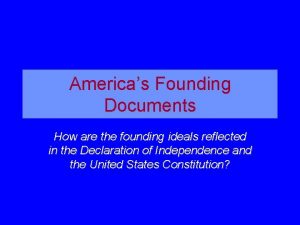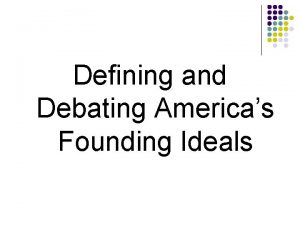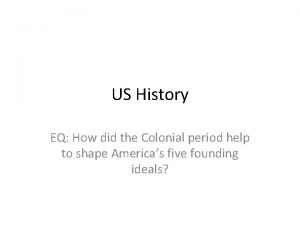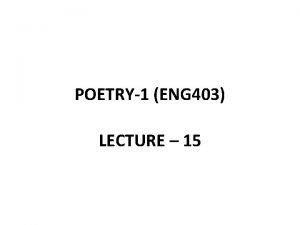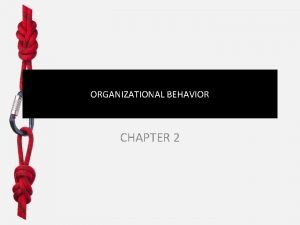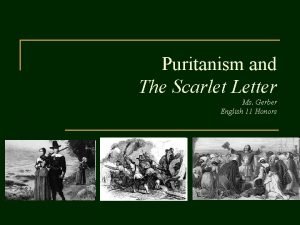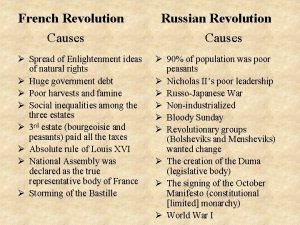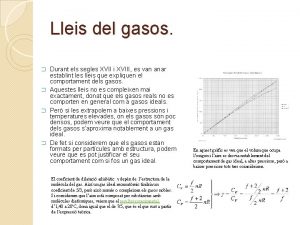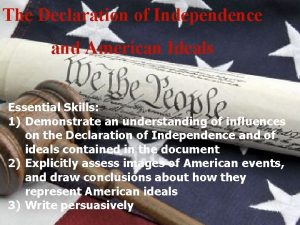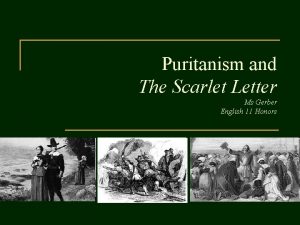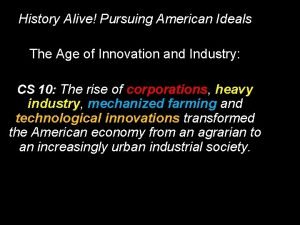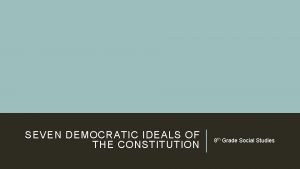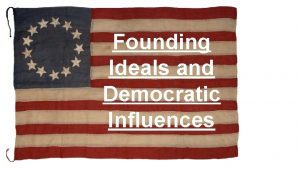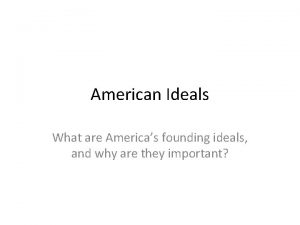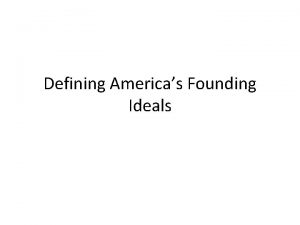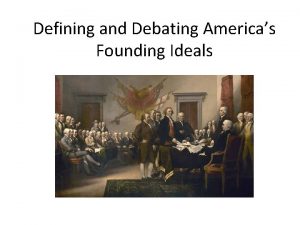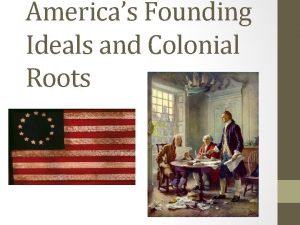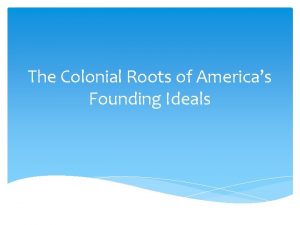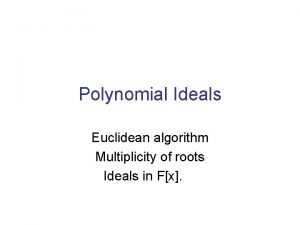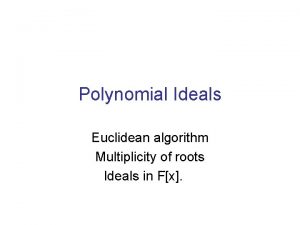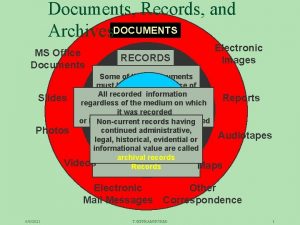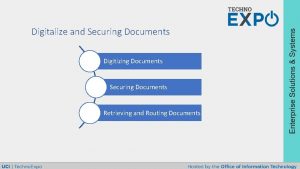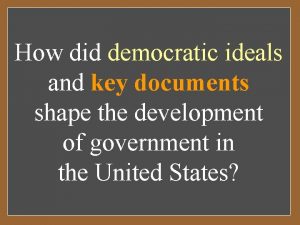Americas Founding Documents How are the founding ideals















- Slides: 15

America’s Founding Documents How are the founding ideals reflected in the Declaration of Independence and the United States Constitution?

Compare the introductions of these documents. • Declaration – 1776 – A petition to inform the king • When, in the course of human events, it becomes necessary for one people to dissolve the political bands which have connected them with another, and to assume among the powers of the earth, the separate and equal station to which the laws of nature and of nature's God entitle them, a decent respect to the opinions of mankind requires that they should declare the causes which impel them to the separation. We hold these truths to be self-evident, that all men are created equal, that they are endowed by their Creator with certain unalienable rights, that among these are life, liberty and the pursuit of happiness. That to secure these rights, governments are instituted among men, deriving their just powers from the consent of the governed. That whenever any form of government becomes destructive to these ends, it is the right of the people to alter or to abolish it, and to institute new government, laying its foundation on such principles and organizing its powers in such form, as to them shall seem most likely to effect their safety and happiness. • • Constitution- 1789 – Provides the basis for American law and the structure of gov. • We the people of the United States, in order to form a more perfect union, establish justice, insure domestic tranquility, provide for the common defense, promote the general welfare, and secure the blessings of liberty to ourselves and our posterity, do ordain and establish this Constitution for the United States of America. 5 ideals? Do they both emphasize the same idea

The US Constitution • What you will learn… – What were the circumstances that impelled the framers to write the Constitution? – What is the structure of the document? • What is the content of the document?

The “Original” constitution • Written by the Continental Congress during the Revolutionary War The Articles of Confederation “a firm league of friendship”

Articles of Confederation • Pros – Provides for a common defense force – Allows each state to retain its independence and sovereignty • State constitutions – Powers • Declare war • Negotiate w/other countries • Postal system • Cons – No power to tax – No power to regulate interstate commerce – No strong central voice for negotiation – No way to deal with Revolutionary debt – No common currency – Inconsistent representation in Congress – 1 state : 1 vote

Articles of Confederation • Successes • Failures – Figuring out what to do with new territory – Land Ordinance of 1785 • Surveying and subdividing • 36 sq. mile townships – Land set aside for schools – Northwest Ordinance • Procedures for settling new land forming new states – Problems with Britain – Trade restrictions between states – Debt – Shay’s Rebellion • Farmers protest falling crop prices and high debt

Constitutional Convention • Convenes May 12, 1787 • 55 delegates • Purpose: revise the Articles of Confederation • Influences – John Locke – Baron de Montesquieu • Balance of power • Checks and balances

checks and balances

55 delegates • • James Madison “Father of the Constitution” Benjamin Franklin George Washington Roger Sherman Compromises had to be made……. .

Important Compromises • Between small states and large states – The “Great Compromise” (Connecticut Compromise) • Bicameral Congress (2 houses) – House of Representatives- based on population – Senate- based on statehood (Each state has two senators) – 3/5 Compromise • Slaves to be counted 3/5 – Electoral College • President to be elected indirectly using the Electoral College

Must be ratified by 9 of 13 colonies • Federalists v. Anti-Federalists argue. • Ratified by 1788 • A Bill of Rights is added (1 st 10 Amendments) – Ratified by 1791

Important Idea Federalism • The central government has specific and limited functions; it has controlling authority – Interstate commerce (trade between states) – Foreign policy/ Affairs – War – “Constitutionality”-Supreme Law of the Land • State governments have specific and limited functions. – Everything else

Arguments over how to interpret the Constitution continue to this day. . . • Civil War • Role of government – Business – Healthcare • War Powers Act • 27 Amendments

Create a table like this in your spiral U. S. Federal Government Legislative Branch Executive Branch Judicial Branch

• For each of the three branches: – How is it structured? (Who’s in it? ) – What is it job? – What are its powers?
 Insidan region jh
Insidan region jh America's founding ideals
America's founding ideals Discovering american ideals in primary sources
Discovering american ideals in primary sources Colonial roots of the founding ideals answers
Colonial roots of the founding ideals answers John milton writing style
John milton writing style Personal attitudes affect behavior via intentions.
Personal attitudes affect behavior via intentions. There are people with gods and lofty ideals
There are people with gods and lofty ideals Puritan ideals
Puritan ideals Enlightenment and french revolution
Enlightenment and french revolution Llei dels gasos
Llei dels gasos Ideals in the declaration of independence
Ideals in the declaration of independence Ideals delegation model
Ideals delegation model Puritan ideals
Puritan ideals Ideals of the renaissance
Ideals of the renaissance History alive pursuing american ideals online textbook
History alive pursuing american ideals online textbook 7 democratic ideals
7 democratic ideals

